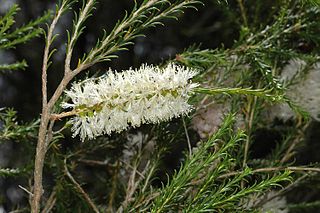Melaleuca apodocephala is a plant in the myrtle family, Myrtaceae and is endemic to the south-west of Western Australia. It is a low, bushy shrub with crowded, grey-green leaves, corky bark and a profusion of creamy-yellow flowers on the sides of the branches.

Melaleuca adnata, commonly known as sandhill honey-myrtle, is a plant in the myrtle family, Myrtaceae and is endemic to the south-west of Western Australia. It is a tall shrub with papery bark and spikes of white flowers in spring and early summer.

Melaleuca blaeriifolia is an erect to spreading shrub in the myrtle family, Myrtaceae and is endemic to a small area in the south-west of Western Australia. It has small leaves and small greenish-yellow flowerheads.

Melaleuca laxiflora, commonly known as narrow-leaved paperbark, is a woody, spreading shrub in the myrtle family, Myrtaceae and is endemic to the south-west of Western Australia. It is distinguished by its loosely arranged, mostly lateral pink flower spikes and its smooth, fleshy, oil-dotted leaves. It is often cultivated because of its hardiness and attractive flowers.

Melaleuca bracteosa is a low, spreading shrub in the myrtle family, Myrtaceae and is endemic to the south-west of Western Australia. It has tiny, fleshy, non-prickly leaves and cream flowerheads.

Melaleuca ciliosa is a small shrub in the myrtle family, Myrtaceae and is endemic to the south-west of Western Australia. It has bright or pale yellow flowers, an unusual calyx and leaves that are slightly hairy, especially around the edges.

Melaleuca concinna is a small shrub in the myrtle family Myrtaceae and is endemic to the south-west of Western Australia. Its species name translates as " neat" or "pretty" and it is distinguished by having many heads of pink flowers in late spring followed by spherical clusters of woody fruits.

Melaleuca cucullata is a large shrub in the myrtle family, Myrtaceae and is endemic to the south-west of Western Australia. Its species name alludes to the shape of the leaves which resemble miniature academics' hoods.

Melaleuca hamulosa is a plant in the myrtle family, Myrtaceae and is endemic to the south-west of Western Australia. It is a broom-like shrub with many stiff, ascending branches and spikes of white or pale mauve flowers in spring or summer.

Melaleuca lateralis is a plant in the myrtle family, Myrtaceae and is endemic to the south-west of Western Australia. It is a showy shrub, well suited to horticulture, distinguished by its very small leaves and small clusters of pink flowers along the older stems.

Melaleuca lutea is a plant in the myrtle family, Myrtaceae and is endemic to Western Australia. This species was previously known as Melaleuca citrina but was renamed to allow Callistemon citrinus to be moved to the genus Melaleuca. It is distinguished by its oval shaped, dense heads of yellow flowers and bushy foliage.

Melaleuca rigidifolia is a shrub in the myrtle family Myrtaceae, endemic to the south of Western Australia. It is similar to Melaleuca plumea with its pink or purple flowers but is distinguished from that species by its lack of fluffy hairs on the flowers and its spherical clusters of fruits.

Melaleuca sparsiflora is a shrub in the myrtle family Myrtaceae, and is endemic to the south-west of Western Australia. It generally grows in heavy soils on the edges of salt lakes and has only one or two flowers at the ends of it branches, unlike the many-flowered heads or spikes of others in the genus Melaleuca.

Melaleuca subfalcata is a shrub in the myrtle family Myrtaceae, and is endemic to the south of Western Australia. It has fibrous bark and pink to purple flowers in spikes, mostly on the side branches.

Melaleuca thyoides, commonly known as salt lake honey-myrtle is a plant in the myrtle family, Myrtaceae and is endemic to the south-west of Western Australia. It is an erect shrub with grey, papery or fibrous bark and very small, overlapping leaves on thin branchlets. It is a salt tolerant species often found on the edges of salt lakes.

Beaufortia cyrtodonta, commonly known as Stirling Range bottlebrush, is a plant in the myrtle family, Myrtaceae and is endemic to the south-west of Western Australia. It is a compact shrub with crowded leaves which appear greyish due to their covering of fine, soft hairs. It has heads of red flowers in spring and occurs in the Stirling Range district.

Hemiphora uncinata is a flowering plant in the mint family Lamiaceae and is endemic to the south-west of Western Australia. It is an erect, spreading shrub with its branches densely covered with white, woolly hairs. Its leaves are rough and wrinkled and the flowers are tube-shaped with deep pink petals with wavy edges.

Boronia pulchella, commonly known as the pink boronia, is a plant in the citrus family, Rutaceae and is endemic to a small area in the south-west of Western Australia. It is a slender shrub with rod-like stems, pinnate leaves and deep pink, four-petalled flowers.

Boronia oxyantha is a plant in the citrus family, Rutaceae and is endemic to a small area in the south-west of Western Australia. It is a shrub with many hairy branches, pinnate leaves and pink, four-petalled flowers that have a darker midrib.
Phebalium microphyllum is a species of small, rounded shrub that is endemic to Western Australia. It has scaly branchlets, leathery, oblong leaves and yellow flowers arranged in umbels of three to six on the ends of branchlets.


















